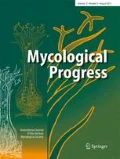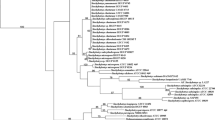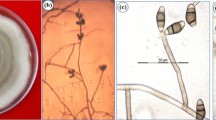Abstract
Four Stachybotrys strains were isolated from soil in China. One was identified as a novel species by morphological characters of phialides and conidia. It produced cylindrical conidia with irregular striations and smooth, hyaline conidiophores. Phylogenetic analysis of three DNA markers, the internal transcribed spacer region of rDNA (ITS1–5.8S–ITS2), the translation elongation factor 1 alpha (tef1) and RNA polymerase II subunit (rpb2), supported the morphological results. The correlation between morphological and molecular-based clustering demonstrated that the studied isolate was a new species. Two other isolates were identified as S. cf. elegans.



Similar content being viewed by others
References
Al-Ahmad M, Manno M, Ng V, Ribeiro M, Liss GM, Tarlo SM (2010) Symptoms after mould exposure including Stachybotrys chartarum, and comparison with darkroom disease. Allergy 65:245–255
Castlebury LA, Rossman AY, Sung GH, Hyten AS, Spatafora JW (2004) Multigene phylogeny reveals new lineage for Stachybotrys chartarum, the indoor air fungus. Mycol Res 108:864–872
Ellis MB (1971) Dematiaceous hyphomycetes. CMI, Kew, pp 1–507
Ellis MB (1976) More dematiaceous hyphomycetes. CMI, Kew, pp 1–608
Etzel R, Montaña E, Sorenson WG, Kullman GJ, Allan TM, Dearborn DG (1998) Acute pulmonary hemorrhage in infants associated with exposure to Stachybotrys atra and other fungi. Arch Pediatr Adolesc Med 152(8):757–762
Farris JS, Källersjö M, Kluge AG, Bult C (1994) Testing significance of incongruence. Cladistics 10:315–320
Haugland RA, Vesper SJ, Harmon S (2001) Phylogenetic relationships of Memnoniella and Stachybotrys species inferred from ribosomal DNA sequences and evaluation of morphological features for Memnoniella species identification. Mycologia 93:54–65
Hillis DM, Bull JJ (1993) An empirical test of bootstrapping as a method for assessing confidence in phylogenetic analysis. Syst Biol 42:182–192
Hintikka EL (2004) The role of Stachybotrys in the phenomenon known as sick building syndrome. Adv Appl Microbiol 55:155–173
Jiang YL, Zhang TY (2009) Notes on soil dematiaceous hyphomycetes from Sichuan Province, China. Mycosystema 28:644–647
Jong SC, Davis EE (1976) Contribution to the knowledge of Stachybotrys and Memnoniella in culture. Mycotaxon 3:409–485
Karunasena E, Cooley JD, Douglas DR, Straus DC (2004) Protein translation inhibition by Stachybotrys chartarum conidia with and without the mycotoxin containing polysaccharide matrix. Mycopathologia 158:87–97
Kong HZ (1997) Stachybotrys yunnanensis sp. nov. and Neosartorya delicata sp. nov. isolated from Yunnan, China. Mycotaxon 12:427–433
Kong JH, Zhang TY, Zhang W (2007) Notes on soil dematiaceous hyphomycetes from Hexi Corridor, Gansu Province. Mycosystema 26:196–201
Li DW (2007) Stachybotrys eucylindrospora, sp. nov. resulting from a re-examination of Stachybotrys cylindrospora. Mycologia 99:332–339
Li QR, Jiang YL (2011) Stachybotrys subreniformis, new from soil in China. Mycotaxon 115:171–173
Li DW, Yang CS (2005) Taxonomic history and current status of Stachybotrys chartarum and related species. Indoor Air 15(suppl 9):5–10
Liu YJ, Whelen S, Hall BD (1999) Phylogenetic relationships among ascomycetes: evidence from an RNA polymerase subunit. Mol Biol Evol 16:1799–1808
Maria GL, Sridhar KR (2003) Diversity of filamentous fungi on woody litter of five mangrove plant species from the southwest coast of India. Fungal Divers 14:109–126
Matsushima T (1971) Microfungi of the Solomon Islands and Papua-New Guinea. Nippon Printing & Publishing, Osaka, Japan. 78p.
Matsushima T (1975) Icones microfungorum: a Matsushima lectorum. Matsushima T (published by the author), Kobe, Japan. p 415.
Mercado-Sierra A, Holubová-Jechova V, Mena-Portales J (1997) Hifomicetos demaciáceos de Cuba, Enteroblásticos. Torino, Museo Regionale di Scienze Naturali, Monografie XIII
Pestka JJ, Yike I, Dearborn DG, Ward MDW, Harkema JR (2008) Stachybotrys chartarum, trichothecene mycotoxins, and damp building-related illness: new insights into a public health enigma. Toxicol Sci 104(1):4–26
Pinruan U, McKenzie EHC, Jones EBG, Hyde KD (2004) Two new species of Stachybotrys, and a key to the genus. Fungal Divers 17:145–157
Rehner S (2001) Primers for elongation factor 1-α (EF1-α). Available from: http://ocid.nacas.org/research/deephyphae/EF1primer.pdf (cited 20 August 2008)
Smith G (1962) Some new and interesting species of microfungi. Trans Br Mycol Soc 45:387–394
Swofford DL (2002) PAUP*: phylogenetic analysis using parsimony (*and other methods), version 4.0b10. Sinauer Associates, Sunderland
Tang AMC, Hyde KD, Corlett RT (2003) Diversity of fungi on wild fruits in Hong Kong. Fungal Divers 14:165–185
Thompson JD, Gibson TJ, Plewniak F, Jeanmougin F, Higgins DG (1997) The Clustsal X windows interface: flexible strategies for multiple sequence alignment aided by quality 1 analysis tools. Nucleic Acids Res 24:4876–4882
Wang HF, Kong JH, Wu YM, Zhang TY (2009) Notes on soil dematiaceous hyphomycetes from the Qaidam Basin, Qinghai Province, China I. Mycosystema 28:20–24
White TJ, Bruns TD, Lee S, Taylor J (1990) Amplification and direct sequencing of fungal ribosomal RNA genes for phylogenetics. In: Innis MA, Gelfand DH, Sninsky JJ, White TJ (eds) PCR Protocols: a guide to method and applications. Academic, New York, pp 315–322
Whitton SR, McKenzie EHC, Hyde KD (2001) Microfungi on the Pandanaceae: Stachybotrys, with three new species. New Zeal J Bot 39:489–499
Wu YM, Zhang TY (2009) Two new species of Stachybotrys from soil. Mycotaxon 109:461–464
Wu YM, Zhang TY (2010) Two new species of Stachybotrys from soil. Mycotaxon 114:459–462
Acknowledgments
This project was supported by the National Science Foundation of China (No. 31060005).
Author information
Authors and Affiliations
Corresponding authors
Additional information
Chun-Yu Jie and Kun Geng contributed equally to the manuscript and should be considered as joint first authors.
Rights and permissions
About this article
Cite this article
Jie, CY., Geng, K., Jiang, YL. et al. Stachybotrys from soil in China, identified by morphology and molecular phylogeny. Mycol Progress 12, 693–698 (2013). https://doi.org/10.1007/s11557-012-0878-y
Received:
Revised:
Accepted:
Published:
Issue Date:
DOI: https://doi.org/10.1007/s11557-012-0878-y




